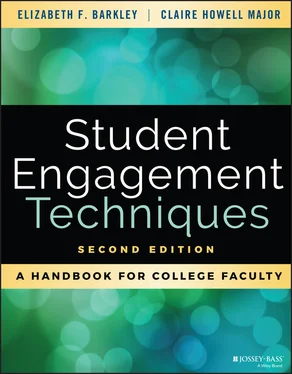Elizabeth F. Barkley - Student Engagement Techniques
Здесь есть возможность читать онлайн «Elizabeth F. Barkley - Student Engagement Techniques» — ознакомительный отрывок электронной книги совершенно бесплатно, а после прочтения отрывка купить полную версию. В некоторых случаях можно слушать аудио, скачать через торрент в формате fb2 и присутствует краткое содержание. Жанр: unrecognised, на английском языке. Описание произведения, (предисловие) а так же отзывы посетителей доступны на портале библиотеки ЛибКат.
- Название:Student Engagement Techniques
- Автор:
- Жанр:
- Год:неизвестен
- ISBN:нет данных
- Рейтинг книги:3 / 5. Голосов: 1
-
Избранное:Добавить в избранное
- Отзывы:
-
Ваша оценка:
- 60
- 1
- 2
- 3
- 4
- 5
Student Engagement Techniques: краткое содержание, описание и аннотация
Предлагаем к чтению аннотацию, описание, краткое содержание или предисловие (зависит от того, что написал сам автор книги «Student Engagement Techniques»). Если вы не нашли необходимую информацию о книге — напишите в комментариях, мы постараемся отыскать её.
— — — —
Student Engagement Techniques
"Student Engagement Techniques
"Student Engagement Techniques
"This book is an essential resource for faculty seeking to better engage with their students. Anyone seeking a clear, research-based, and actionable guide needs a copy of Student Engagement Techniques on their shelf!"
Student Engagement Techniques — читать онлайн ознакомительный отрывок
Ниже представлен текст книги, разбитый по страницам. Система сохранения места последней прочитанной страницы, позволяет с удобством читать онлайн бесплатно книгу «Student Engagement Techniques», без необходимости каждый раз заново искать на чём Вы остановились. Поставьте закладку, и сможете в любой момент перейти на страницу, на которой закончили чтение.
Интервал:
Закладка:
Learning is acquiring information or “knowing a lot.”
Learning is memorizing or “storing” information.
Learning is acquiring facts and skills that can be used.
Learning is making sense or “making meaning” of the various parts of information.
Learning involves comprehending or understanding the world by reinterpreting knowledge. (cited in Ramsden, 1992, pp. 26–27)
This final level echoes the definitions of active learning. Deep or active learning approaches, then, are evident when students seek deeper understanding rather than surface information , the latter of which rests lightly on the surface, inert and unassimilated. Some students come equipped with deep learning approaches, but instructors can also help students develop or improve such approaches.
What Are Active Learning Techniques?
Active learning strategies or techniques, sometimes confusingly referred to as simply active learning, refers to several specific models of instruction, which range from more to less structured, including discussion, worksheets, cooperative and collaborative learning, discovery learning, experiential learning, problem-based learning, and inquiry-based learning. It is easy to conflate active learning with group work, thinking, for example, that simply breaking a class into small groups so that more students have a chance to participate will result in student engagement. This belief is reinforced by NSSE and CCSSE survey questions that ask students to report the frequency with which they've participated in group activities, with the assumption that the larger the number, the more “engaged” that institutions' students are presumed to be. Bowen (2005) points out that NSSE, “which assesses the extent to which these pedagogies are used, has become one de facto operational definition of engagement” (p. 4).
We suggest that active learning techniques prompt students to engage in different learning tasks. By learning task, we mean the responsibility that an instructor expects students to do to help them meet important learning outcomes. By active learning technique, we mean the specific activity that the teacher intentionally designed to prompt students to complete the task. In Table 3.1, we offer examples of the tasks that can require active learning and techniques that can prompt them.
TABLE 3.1.Active Learning Tasks and Techniques
| Active Learning Task | Active Learning Technique |
| Listening | Analytic teams . Students assume predetermined roles while listening to a lecture. (SET 13) |
| Problem-solving | Send a problem . Students try to solve a problem as a group, and then pass the problem and solution to a nearby group who does the same; the final group evaluates the solutions. (Barkley & Major, 2016, CoLT 14) |
| Reading | Active Reading Documents (ARDs) . Carefully prepared forms guide students through the process of critical and careful reading. (Barkley & Major, 2018, ALT 1) |
| Discussing | Two-Minute Question-Development Talks (TQDTs) . Student pairs share ideas and information about out-of-class assignments. Their exchange involves two questions: “What was the main thing you learned from the assignment?” “What questions about the assignments do you have?” (Barkley & Major, 2018, ALT 3) |
| Writing | Dyadic Essays: Students write essay questions/model answers, exchange questions, and after responding compare their answers to the model answer. (Barkley & Major, 2016, CoLT 26) |
The Relationship Between Active Learning and Active Learning Techniques
Just engaging students in a given task is not sufficient. It is not safe, for example, to conclude that if students are talking to each other they are learning. It is equally risky to conclude that students are learning when they are listening to other students talking. Something beyond the task has to happen for active learning to occur.
We propose that when identifying a technique to promote active learning in a college course, teachers should consider not only the learning task but also a goal for the level of activity involved. By level of activity, we mean students' mental investment and the strategies they use to reflect on and monitor the processes and the results of their learning (Barkley & Major, 2018). Level of activity is a discrete component because one type of learning task does not necessarily demand more mental investment than another; rather, each type of learning task can require more or less mental activity depending on the individual learner as well as the content and design of the specific task. For example, although some educators argue that students who are listening to a lecture are necessarily learning more passively than those who are solving problems, consider the following problem: X + 3 = 5. Most college students can solve this problem without too much mental activity. However, college students who are listening carefully to a lecture can have high levels of mental activity, including focused attention, curiosity, empathy, critical thinking, and so forth. Thus, students can have low to high levels of mental activity in any given learning task and any given learning task can require and result in more or less active learning from students. We offer our own conception of the active learning continuum for several key learning tasks in Table 3.2(from Barkley & Major, 2018, pp. 22–23).
The challenge for faculty who wish to employ active learning techniques to promote deeper, more active learning is to find techniques that can help students move from level 1 (low) to level 3 (high) on the continuum in terms of their mental activity, whatever the learning task happens to be. Active learning techniques are a vehicle to help students not only take on the task but also engage in the higher levels of active learning.
TABLE 3.2.The Active Learning Continuum for Several Key Learning Tasks
| LearningTask | Level of Mental Activity | ||
| 1 Low | 2 Moderate | 3 High | |
| Listening | Listens for facts and information | Maintains concerted attention while trying to understand the message and to formulate questions about the message | Expresses interest and enthusiasm; attempts to critique and evaluate the message; monitors own attention |
| Problem-solving | Solves the problem | Recognizes the underlying structure of the problem | Considers the processes for solving the problem and self-monitors efforts and progress |
| Reading | Seeks facts and information | Seeks structural understanding | Seeks meaning and monitors own reading engagement; investigates related readings and resources |
| Discussing | Relays facts | Conveys ideas and concepts and encourages others | Shares personal perspectives and seeks to understand others; argues and evaluates concepts; self-monitors participation |
| Writing | Describes and defines | Explains and applies; expresses personal perspectives; seeks out references | Critiques, evaluates, and creates; seeks to express personal perspectives and connect with others' ideas; monitors progress and assesses quality |
Conclusion
Learning is a dynamic process in which learners literally “build” their own minds by constantly making and changing connections between what is new and what is already known. Deep, long-term learning occurs when changed connections result in reformatted structures—whether these structures are described as schemata or neuronal networks. As much as we (and often students!) would like to think that we as teachers can simply transfer knowledge into learners' brains, it is simply not possible. Students need to do the work required to learn. We can help them by setting up conditions for active learning. By being active participants in their own learning, students “build” their own minds at the level of involvement required for engaged learning.
Читать дальшеИнтервал:
Закладка:
Похожие книги на «Student Engagement Techniques»
Представляем Вашему вниманию похожие книги на «Student Engagement Techniques» списком для выбора. Мы отобрали схожую по названию и смыслу литературу в надежде предоставить читателям больше вариантов отыскать новые, интересные, ещё непрочитанные произведения.
Обсуждение, отзывы о книге «Student Engagement Techniques» и просто собственные мнения читателей. Оставьте ваши комментарии, напишите, что Вы думаете о произведении, его смысле или главных героях. Укажите что конкретно понравилось, а что нет, и почему Вы так считаете.












